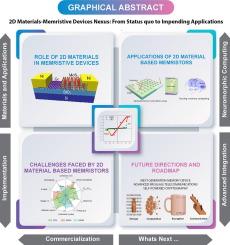2D materials-memristive devices nexus: From status quo to Impending applications
IF 40
1区 材料科学
Q1 MATERIALS SCIENCE, MULTIDISCIPLINARY
引用次数: 0
Abstract
The incorporation of 2D materials into memristive devices has boosted advancements in non-volatile memory (NVM), and other related applications including brain inspired neuromorphic systems, artificial intelligence (AI)-machine learning (ML), optoelectronics, photonics, implementing arithmetic operations, and hybrid CMOS architectures. These advancements have taken place among limitations on silicon-based flash and surging data demands, stimulating the research of innovative materials and architectures, particularly for the next generation memory devices. This comprehensive review expands upon the cutting-edge developments in 2D material-based memristors, including their fabrication techniques, performance evaluation, fundamental properties, diverse applications, further challenges in their modernization, and future road map. By emphasizing the distinct characteristics of 2D materials, we reviewed their memristive behavior and highlighted the major contributions by leading researchers over the years. Focus of this review is on the incorporation of graphene (derivatives of graphene), transition metal dichalcogenides (TMDs), and other 2D materials (like MXenes and nanocomposites) in various memristive architectures. The review paper systematically explored the specific roles of graphene and other 2D materials in memristor devices including their use as electrodes, active layers, barrier layers, interfacial layers, and tunnel layers. The major challenges faced by the 2D material based memristor technology hindering their advancement have been critically reviewed including the scalability, yield, hardware implementation, performance enhancement, fabrication techniques, material/device engineering, and commercialization of these devices. Workable solutions to those problems along with the clear and comprehensive road map of future directions for addressing these hurdles have been recommended to unlock the full potential of this transitional technology. This review provides an authoritative resource and compelling rationale for researchers working towards metamorphic memristor solutions by emphasizing the imperative role of 2D materials.


二维材料-记忆器件关系:从现状到即将到来的应用
将二维材料应用于存储器件推动了非易失性存储器(NVM)及其他相关应用的发展,这些应用包括大脑启发神经形态系统、人工智能(AI)-机器学习(ML)、光电子学、光子学、实现算术运算以及混合 CMOS 架构。这些进步是在硅基闪存受到限制和数据需求激增的情况下取得的,激发了对创新材料和架构的研究,特别是对下一代存储器件的研究。本综述全面阐述了基于二维材料的忆阻器的前沿发展,包括其制造技术、性能评估、基本特性、各种应用、现代化过程中的进一步挑战以及未来路线图。通过强调二维材料的独特特性,我们回顾了它们的忆阻行为,并重点介绍了多年来顶尖研究人员的主要贡献。本综述的重点是将石墨烯(石墨烯的衍生物)、过渡金属二掺杂物(TMDs)和其他二维材料(如 MXenes 和纳米复合材料)纳入各种记忆架构。综述论文系统地探讨了石墨烯和其他二维材料在忆阻器器件中的具体作用,包括用作电极、活性层、阻挡层、界面层和隧道层。文章对基于二维材料的忆阻器技术所面临的阻碍其发展的主要挑战进行了批判性评述,包括这些器件的可扩展性、产量、硬件实现、性能提升、制造技术、材料/器件工程以及商业化。针对这些问题提出了可行的解决方案,并为解决这些障碍提出了清晰而全面的未来发展方向路线图,以充分释放这一过渡性技术的潜力。这篇综述强调了二维材料的重要作用,为研究人员提供了权威的资源和令人信服的理论依据,帮助他们找到变质忆阻器的解决方案。
本文章由计算机程序翻译,如有差异,请以英文原文为准。
求助全文
约1分钟内获得全文
求助全文
来源期刊

Progress in Materials Science
工程技术-材料科学:综合
CiteScore
59.60
自引率
0.80%
发文量
101
审稿时长
11.4 months
期刊介绍:
Progress in Materials Science is a journal that publishes authoritative and critical reviews of recent advances in the science of materials. The focus of the journal is on the fundamental aspects of materials science, particularly those concerning microstructure and nanostructure and their relationship to properties. Emphasis is also placed on the thermodynamics, kinetics, mechanisms, and modeling of processes within materials, as well as the understanding of material properties in engineering and other applications.
The journal welcomes reviews from authors who are active leaders in the field of materials science and have a strong scientific track record. Materials of interest include metallic, ceramic, polymeric, biological, medical, and composite materials in all forms.
Manuscripts submitted to Progress in Materials Science are generally longer than those found in other research journals. While the focus is on invited reviews, interested authors may submit a proposal for consideration. Non-invited manuscripts are required to be preceded by the submission of a proposal. Authors publishing in Progress in Materials Science have the option to publish their research via subscription or open access. Open access publication requires the author or research funder to meet a publication fee (APC).
Abstracting and indexing services for Progress in Materials Science include Current Contents, Science Citation Index Expanded, Materials Science Citation Index, Chemical Abstracts, Engineering Index, INSPEC, and Scopus.
 求助内容:
求助内容: 应助结果提醒方式:
应助结果提醒方式:


